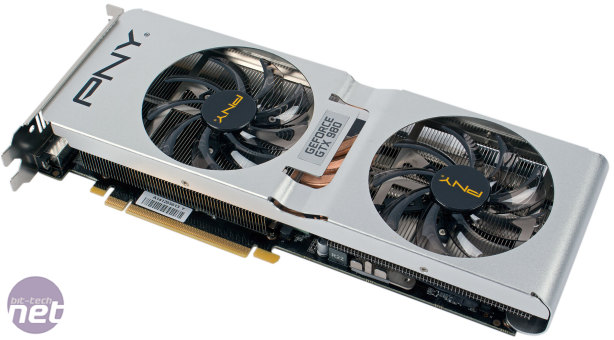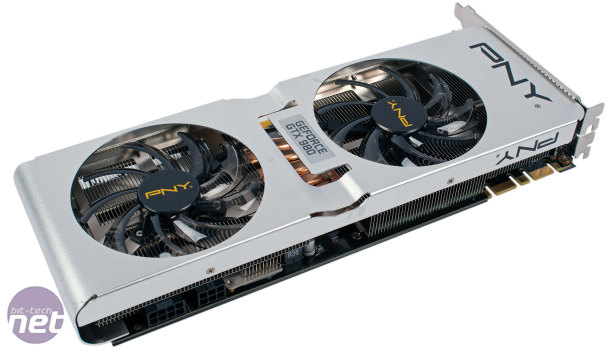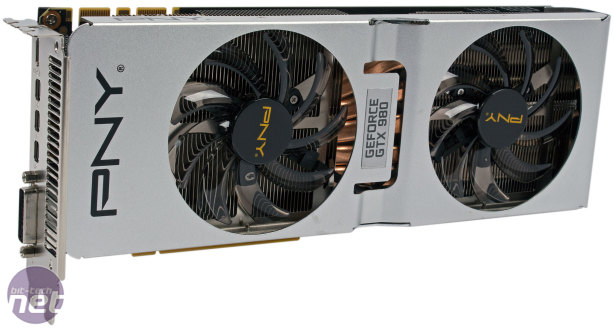
Performance Analysis
Evidently, this is a very fast card, though that's hardly surprising. In Battlefield 4, the GTX 980 OC2 gets off to a great start – at 1440p, its minimum frame rate is 8fps (18 percent) more than the Asus GTX 980 Poseidon Platinum, despite it only having a 4 percent faster core and 3 percent faster memory. Evidently, Nvidia has been working on its drivers, as there was previously a section in this benchmark where the minimum would drop quite far compared to the average, but this now appears to be overcome. We no longer have the Asus sample to test with the newer drivers, but we'll be retesting a number of cards soon on a new system, so stay tuned. At 4K, the overclock and updated drivers get this card up to a 33fps minimum. Arguably, you want more than that for a game like Battlefield 4, but with a G-Sync monitor this would still be a very pleasant experience.In BioShock Infinite, the PNY flagship has no trouble, with 80fps minimum at 1440p and 40fps at 4K meaning you're guaranteed smooth frame rates. It's even better in Skyrim, of course, where it manages to sustain more than 60fps at 4K. The card is pretty much in its own league – way ahead of the R9 290X, but still very far behind Nvidia's GTX Titan X.
The most demanding game is Crysis 3. At 1440p, it can handle the punishment this game doles out, with a solid minimum of 44fps again making it ripe for G-Sync. However, at 4K, it finally crumbles, with just a paltry 21fps. Even the GTX Titan X only manages 25fps here though – without dual GPUs, you've got no chance of running this game smoothly at 4K.
The Unigine score is naturally impressive, and PNY's finest trumps the reference GTX 980 by 10 percent at 1080p and 13 percent at 1440p.
Power consumption is a little higher than with Asus's card, but that makes sense given the faster core and memory. Interestingly, Galax's and Gigabyte's cards recorded higher power consumption despite having the same core clock and slower memory. Of course, the GTX 980 is very efficient however you look at it, but PNY's model here appears to be particularly so.
The dual fan cooler knocks 8°C off the temperature of the stock card, while of course running faster. Under sustained load, PNY's fans span up to about 75 percent, or 2,250 RPM. This sounds like a lot on both counts, but the fan design means that it's actually very quiet – we struggled to hear them, and they're much quieter than reference. They provide a great balance between noise and cooling, and there's headroom to limit the fan speed and noise further if you wish. We have seen cooler running GTX 980s, but they're also louder. It's a shame PNY didn't make the card semi-passive, but then again we'd be very surprised if you could hear it above the rest of your PC and environment when it's running idle. There were also no issues with coil whine or the like.
The 9 percent core overclock and 12.5 percent memory one saw performance improve by between 9 and 11 percent – right on the money. Temperatures and fan speeds only climbed slightly, certainly nothing to be of concern, while total power consumption rose to 364W; still some way off using an R9 290 or R9 290X. With only the R9 295X2 and GTX Titan X ahead of it, the PNY GTX 980 OC2 was never going to improve its standing in the charts, but free performance is always welcome round these parts.
Conclusion
£500 is a large sum of money for graphics hardware, but the PNY GTX 980 OC2 Pure Performance also delivers well in almost every way. It comes with a comprehensive cooling solution that keeps both temperatures and noise levels respectably low and is also very well made and great-looking. It's a much-improved aesthetic compared to previous PNY offerings, which is very important at this end of the market. Our one gripe is the mini display outputs – we'd have preferred PNY to stick to standard size ones or supply some adaptors, as these will likely be added cost for most users.Of course, the card is also very fast in games. At 1440p, it's without issue and is the perfect candidate to pair with a G-Sync monitor. At 4K, it's a fairly enjoyable experience too, although to play modern games with full settings at this resolution smoothly, you will need even more firepower. Dual GPU solutions provide much better value, though the same could be said of any GTX 980 really. With the R9 295X2 now at just £500, and a pair of R9 290Xs or GTX 970s available for around £520-£530, you can achieve much higher frame rates for the same cash, but only if you're willing to go multi-GPU, which isn't without its performance quirks. For single GPU, your only option is a different GTX 980 at this price. Gigabyte's G1 Gaming model costs around £20 less with the same core clock speed, but it has no memory overclock and is louder and bigger too. Relative to the rest of the GTX 980 market, PNY's card is quite fairly priced given what it offers, and would be a welcome inclusion on any high-end shopping list.

-
Performance37 / 40
-
Features28 / 30
-
Value18 / 30


MSI MPG Velox 100R Chassis Review
October 14 2021 | 15:04











Want to comment? Please log in.